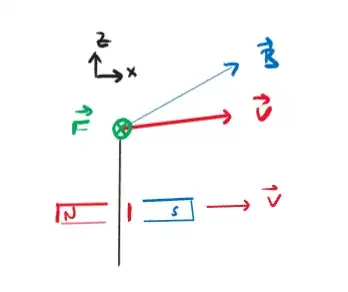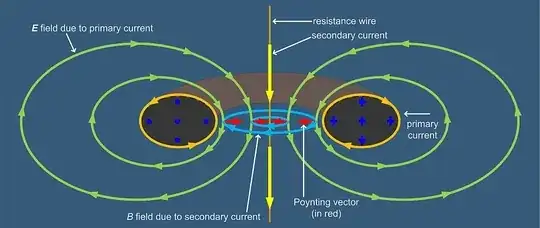My question is, could this law be understood from a force interpretation perspective?
Half-yes. A kind of force, electromotive force, can be used to express and understand Faraday's law, and this is how Maxwell formulated it (and also what we mean today by Faraday's law as opposed to the Maxwell-Faraday equation). But even then, Faraday's law is still about the fact this electromotive force is given by the rate of change of magnetic flux.
Let us see how force comes into this.
Originally, Faraday formulated his law close to this: when the number of magnetic field lines going through a circuit changes, this induces electric current in the circuit, proportional to rate of that change.
Maxwell expressed this in terms of electric and magnetic field components, and a particular concept of force - the electromotive force (EMF), with the understanding that electric current is proportional to it. His formulation was close to this:
When magnetic flux through a circuit changes in time, there is "induced EMF" acting on the electric current in it as well, and this induced EMF is proportional to rate of change of that magnetic flux.
So, Maxwell formalized Faraday's description - instead of mentioning the induced current, he introduced induced EMF, which is a description of the effect of the force in a closed path - but magnetic field lines or magnetic flux still play central role in Maxwell's account of Faraday's law.
Faraday's law can't really be stripped of the notion of magnetic flux (or some equivalent notion such as the number of magnetic field lines). If someone does it and replaces it with e.g. changing distant electric currents in the past, then they may end up with some part of an alternative formulation of EM theory, but it would not be appropriate to call it Faraday's law.
What is EMF (for a closed path) in general? For any particular force (say, $k$-th force) acting on mobile charged particles, we can calculate the following line integral over closed path of the circuit $\gamma$, at a single time:
$$
EMF_k(t) := \oint_\gamma \mathbf f_k(\mathbf x,t) \cdot d\mathbf x.
$$
This is the EMF for a closed path, associated with that $k-$th force.
It turns out (I'm not sure if Maxwell himself knew this, but I think it's likely) that Maxwell's induced EMF in a circuit made of thin wire can be understood as line integral of the following expression (it has dimensions of force per unit charge):
$$
\mathbf f = \mathbf E + \mathbf w\times \mathbf B,
$$
where $\mathbf w$ is velocity of the wire or the conductor body element; it is not the velocity of the mobile charged particles unless electric current is zero.
Here people get confused, because the formula looks like the Lorentz force formula for force on a charged particle, and they think, see, the induced EMF is just due to the effect of the Lorentz forces of the magnet on the charged particles in the wire. But $\mathbf w$ is velocity of the wire, not velocity of the charged particles $\mathbf v_a$ in the wire, which may be different when current flows. So the formula is not a trivial sum of Lorentz forces by the magnet. It is deceiving to say the whole process is just due to the Lorentz forces by the magnet acting on the mobile charge. There are other forces by the wire as well, constraint forces which keep the charge inside the wire, which are important. This is better seen in the frame of the magnet, where the magnet is still and the wire moves; there, magnetic field is static, and the electric field vanishes. There is non-zero induced EMF (so-called motional EMF) also in this frame, and it is correctly given by the line integral of the magnetic term $\mathbf w\times\mathbf B$. However, this force at any element of the wire is not simply a sum of magnetic Lorentz forces by the magnet. This force does work on the mobile charge and transfers energy to them/from them, something magnetic Lorentz forces can't do.
To bring all of that together, Maxwell's induced EMF in a closed circuit, which may be still or moving, can be expressed as
$$
EMF = \oint_\gamma (\mathbf E + \mathbf w\times \mathbf B) \cdot d\mathbf x.
$$
where $\mathbf w$ is velocity of the wire(conductor) element $d\mathbf x$.
If we interpret the result like this:
$$
\mathbf F = e \mathbf v \times \mathbf B
$$
This is the force exerted by the magnet on the wire.
You mean the force on a mobile charge in the wire (the force on the wire is different and not really connected to Faraday's law). This can be correct for an electron, if $e$ is positive number. A much better way to write it is
$$
\mathbf F = - q \mathbf v \times \mathbf B,
$$
where $q$ is charge of the mobile charged particle. If $q = -e$ as in the case of an electron, then we get your formula.
I'm curious how you got to this formula. It's not clear this is the exact formula for the force, but there is an argument that it is at least approximately correct (for non-relativistic velocities), which follows.
The integral formula for EMF which I gave above suggests(not proves) there is an actual force on the mobile charge $e$ equal to:
$$
\mathbf F = q \mathbf E + q\mathbf w \times \mathbf B,
$$
where $\mathbf w$ is velocity of the wire. Since it is zero in the example (the wire is still, so $\mathbf w = 0$), the magnetic term drops out and we have just
$$
\mathbf F = q \mathbf E.
$$
where $\mathbf E$ is electric field of the moving magnet.
It turns out that electric field of a moving magnet, assuming the magnet is not charged, can be expressed (at least approximately), as
$$
\mathbf E = -\mathbf v \times \mathbf B \tag{*}.
$$
This can be seen from the following argument. Approximately, magnetic field is the same in both frames, and in the frame of the magnet, the wire moves with velocity $-\mathbf v$. So in the frame of the magnet, any test charged particle moving with the wire has to experience magnetic Lorentz force $-q\mathbf v\times \mathbf B$. Since force on this test charge is approximately the same in both frames, force of approximately the same magnitude acting on the test charge is present also in the frame of the wire. But in this frame, since the test charge does not move, it can be only due to electric
field whose vector is $\mathbf E = -\mathbf v\times \mathbf B$.
This whole argument could be made more precise by doing exact Lorentz transformation of the magnet EM field between both frames. I'm not sure if the formula (*) turns out to be exactly correct, or just an approximation.
With this or some other correct justification for the fact electric field of a moving magnet is given by the above formula (*), your explanation of the induced EMF action on current as due to force by the magnet acting on mobile charge in the wire is correct and standard. The force turns out to be the electric force due to electric field of the magnet.
Induced EMF in general is really due to all EM and constraint forces (by the wire, preventing the charge from jumping out of the conductor), acting on the mobile charge in the wire.

